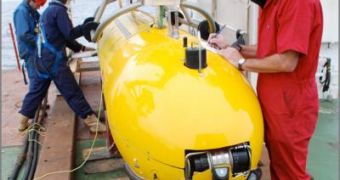The Autonomous Underwater Vehicle (AUV) Autosub6000 is one of the latest, deep-sea exploration vehicles to come out of the United Kingdom. Originally designed to have a maximum diving depth of 6,000 meters, it has been recently tested – at a number of rough locations – at a depth of 3.5 miles (5.63 kilometers), very close to its maximum capabilities. The “test drives” have taken place in the Iberian Abyssal Plain of the North Atlantic, and also at the Casablanca Seamount, between Madeira and Morocco.
Experts at the National Oceanography Center in Southampton have been behind the recent accomplishment, most precisely scientists and engineers from the Underwater Systems Laboratory. The teams here have been in charge of designing and constructing the autonomous submarine, which has yielded such good results.
Some of the new mission's highlights and accomplishments include: 1. successfully completing operations at a 5,600-meter depth. Very few (if any) AUVs have ever operated autonomously at this depth; 2. carrying out a survey at an altitude of three meters, thus paving the way for deep-ocean photographic surveys; 3. following the underwater terrain at an altitude of ten meters over very rough landscape; 4. tests of the improved fault-detection software that allow the AUV to recover from hardware faults; 5. testing of the recently fitted magnetometer, turbidity and precision salinity sensors.
“Apart from the correct functioning of the vehicle during the trials at extreme depths, what particularly pleased me was that we have now developed the control and obstacle avoidance systems such that we have the confidence to send the AUV into a hostile and rugged terrain. This will lead to more challenging and interesting scientific campaigns in the future,” Autosub6000 project leader Steve McPhail says. The next mission for the amazing machine will take place in April 2010 near the Cayman islands, where it will accompany the underwater craft Isis in search of deep hydrothermal vents.
One of the things that allow Autosub6000 to operate at such increased levels of safety is the fact that it has been outfitted with a forward-looking, vertically scanning, obstacle-detection sonar, which enables it to steer clear of harm's way. It also benefits from improved terrain-following control software, which allows it to stay close to the seabed without actually touching it.
The National Oceanography Center in Southampton is a collaboration between the University of Southampton and the Natural Environment Research Council. It is one of the world's leading institutions devoted to research, teaching and technology development in ocean and earth science. Over 500 research scientists, lecturing, support and seagoing staff are based at the center's purpose-built waterside campus in Southampton, along with over 700 undergraduate and postgraduate students.

 14 DAY TRIAL //
14 DAY TRIAL //